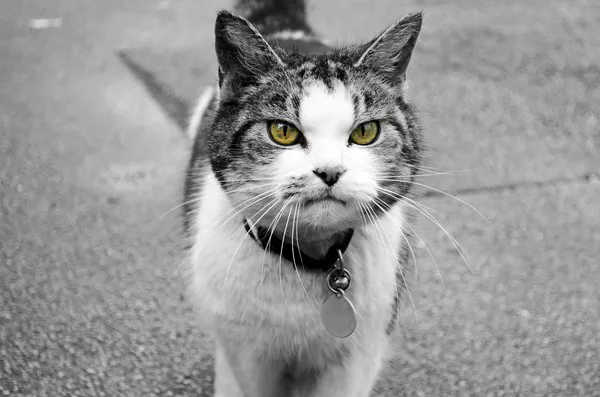Ensuring your cat‘s health is an essential responsibility of pet ownership. Unlike humans, cats often hide signs of illness, making regular health assessments crucial. This article provides a detailed guide on how to monitor your cat’s health effectively, focusing on various aspects such as behavior, physical appearance, weight, and basic health checks. By paying attention to these areas, you can detect potential issues early and ensure your feline companion remains healthy and happy.
Regular Observations
1. Behavior Changes
One of the first signs that something may be wrong with your cat is a change in behavior. Cats are creatures of habit, and any deviation from their normal routine can indicate underlying health problems. Here are some specific behaviors to watch for:
Lethargy: If your cat is less active than usual or shows a lack of interest in playing or exploring, this could be a sign of illness. Cats typically have bursts of energy, and prolonged inactivity can indicate pain or discomfort.
Aggression: A normally friendly cat that becomes aggressive may be experiencing pain or discomfort. Changes in temperament can also occur due to stress or anxiety, so it’s essential to consider the context.
Hiding: Cats often seek out quiet places when they’re not feeling well. If your cat is hiding more than usual, it could be a signal that they’re unwell. Pay attention to where they choose to hide, as some spots may indicate anxiety or fear.
2. Eating and Drinking
Monitoring your cat’s eating and drinking habits is crucial for assessing their health. Changes in appetite can signal various health issues, including dental problems, gastrointestinal disorders, or even systemic illnesses. Here’s what to keep in mind:
Sudden Decrease in Appetite: If your cat suddenly stops eating or drinking, it could indicate a serious health concern. Monitor for other signs such as vomiting, diarrhea, or lethargy, and consult a veterinarian if these issues persist.
Increased Appetite: Conversely, if your cat begins eating significantly more than usual, it may signal a metabolic disorder such as diabetes or hyperthyroidism. Keeping a feeding schedule and noting any changes can provide valuable information to your vet.
Physical Appearance
3. Coat and Skin
A cat’s coat and skin can reveal a lot about their overall health. Regularly check for the following:
Shiny, Healthy Coat: A healthy cat should have a shiny coat that feels smooth to the touch. Dull or brittle fur can indicate nutritional deficiencies or underlying health problems.
Absence of Bald Spots: Spotting bald patches or excessive grooming can be a sign of allergies, parasites, or stress. If you notice these changes, it may be time for a veterinary visit.
Fleas and Dandruff: Check for signs of fleas, ticks, or excessive dandruff. Regular grooming can help control these issues and keep your cat’s coat healthy.
4. Eyes, Ears, Nose, and Mouth
The condition of your cat’s eyes, ears, nose, and mouth can provide insights into their health:
Clear Eyes: Healthy cat eyes should be bright and clear. Redness, discharge, or cloudiness can indicate eye infections or other health issues.
Clean Ears: Your cat’s ears should be clean and free from discharge. Dark, waxy buildup can suggest ear mites or infections.
Moist Nose: A moist, cool nose is generally a sign of good health. A dry or excessively warm nose could indicate fever or dehydration.
Dental Health: Dental issues are common in cats. Check for bad breath, red gums, or broken teeth, which can signify dental disease. Regular dental care is crucial for overall health.
Weight and Body Condition
5. Weight Monitoring
Maintaining a healthy weight is vital for your cat’s overall health. Here’s how to manage their weight effectively:
Regular Weight Checks: Weigh your cat regularly to monitor any changes. You can use a kitchen scale for small cats or take them to the vet for a precise measurement.
Healthy Weight Guidelines: Consult with your veterinarian about the ideal weight for your cat. A sudden loss or gain in weight can indicate underlying health problems and should be addressed promptly.
6. Body Condition Score
Assessing your cat’s body condition score (BCS) is an effective way to determine their overall health:
How to Assess BCS: Feel along your cat’s sides. You should be able to feel their ribs without excessive fat covering. A healthy cat will have a defined waist when viewed from above.
Identifying Weight Issues: If your cat has no waist and you can’t feel their ribs easily, they may be overweight. Conversely, if their ribs are easily felt and they have no fat covering, they may be underweight. Both conditions can lead to health problems.
Basic Health Checks
7. Temperature
Knowing how to take your cat’s temperature is essential for identifying potential illnesses. Here’s how to do it safely:
Using a Digital Rectal Thermometer: Lubricate the thermometer and gently insert it into the rectum. Hold it in place until it beeps.
Normal Temperature Range: A healthy cat’s temperature typically ranges from 100.4 to 102.5°F (38 to 39.2°C). If your cat’s temperature falls outside this range, consult your veterinarian.
8. Pulse and Respiration
Monitoring your cat’s pulse and respiration can provide further health insights:
Checking Pulse: Feel for the femoral artery located inside your cat’s thigh. Count the beats for 15 seconds and multiply by four to determine the pulse rate. A normal pulse rate for cats is between 140-220 beats per minute.
Counting Respiration: Observe your cat’s chest as they breathe. Count the number of breaths for 15 seconds and multiply by four. The normal respiration rate for cats is between 20-30 breaths per minute.
9. Signs of Illness
Being aware of common signs of illness can help you act quickly if something is wrong:
Vomiting: Occasional hairballs are normal, but frequent vomiting can indicate gastrointestinal problems or dietary issues.
Diarrhea: Any sudden change in stool consistency warrants attention, especially if it persists for more than a day.
Coughing and Sneezing: These can be signs of respiratory infections or allergies. If these symptoms last more than a day or are accompanied by other signs, consult your vet.
Limping: Limping can result from injuries, arthritis, or other underlying conditions. Monitor your cat’s mobility and seek veterinary advice if limping persists.
Chronic Conditions
Certain chronic conditions are common in cats and require ongoing monitoring:
Kidney Disease: Common in older cats, symptoms include increased thirst, frequent urination, and weight loss. Regular veterinary check-ups are crucial for early detection.
Diabetes: Watch for increased thirst, excessive urination, and weight loss. Early intervention is vital to manage this condition effectively.
Preventive Care
Vaccinations
Keeping up with your cat’s vaccinations is essential for preventing common diseases. Consult your veterinarian to ensure your cat is up-to-date with their shots, which may include:
- Feline Viral Rhinotracheitis (FVR)
- Calicivirus (FCV)
- Panleukopenia (FPL)
- Rabies: Required by law in many areas.
Parasite Control
Regular parasite control is vital for your cat’s health. This includes:
Flea and Tick Prevention: Use vet-recommended products to protect your cat from fleas and ticks, which can transmit diseases.
Worm Prevention: Regular deworming is essential, especially for kittens. Consult your vet for appropriate products.
Dental Care
Dental health is often overlooked in cats, but it’s crucial for overall health:
Brushing: Brush your cat’s teeth regularly with toothpaste formulated for pets. This helps prevent plaque buildup and dental disease.
Routine Vet Cleanings: Schedule regular dental cleanings with your veterinarian to maintain your cat’s dental health.
When to Seek Veterinary Advice
Recognizing urgent symptoms that require immediate veterinary attention can save your cat’s life:
Difficulty Breathing: This can indicate severe respiratory distress or other critical issues.
Seizures: Seizures can be caused by various conditions, including epilepsy or poisoning. Immediate veterinary care is crucial.
Severe Lethargy: If your cat is excessively lethargic and unresponsive, this may indicate a serious underlying condition.
Routine Check-Ups
Regular veterinary check-ups are vital for your cat’s health. These visits allow for:
Thorough Health Assessments: Your veterinarian will conduct a comprehensive health evaluation, identifying potential issues before they become serious.
Vaccination Updates: Ensure your cat’s vaccinations are current to protect against preventable diseases.
Early Detection: Regular check-ups can help detect chronic conditions early, improving the chances of successful management.
Conclusion
Monitoring your cat’s health is an ongoing responsibility that requires attention to detail and regular observation. By keeping an eye on behavior changes, eating habits, physical appearance, and conducting basic health checks, you can detect potential health issues early. Being proactive in your cat’s health care not only ensures a longer, happier life for your feline companion but also strengthens the bond between you and your pet. By staying informed and vigilant, you can provide your cat with the best possible care, contributing to their overall well-being and happiness. Always remember, when in doubt, consult your veterinarian for professional guidance on your cat’s health.
Related Topics



























